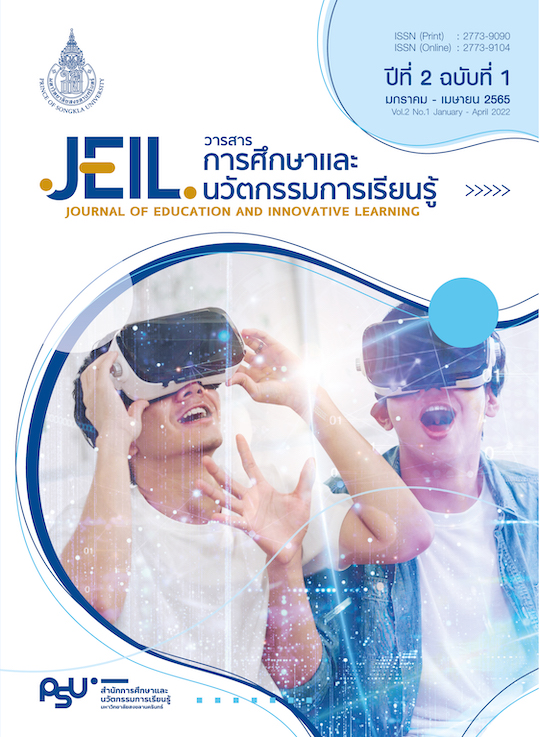ประสิทธิผลของรูปแบบการจัดการเรียนรู้เชิงรุกที่หลากหลายในวิชาเคมีคลินิก
Main Article Content
บทคัดย่อ
การวิจัยครั้งนี้มีวัตถุประสงค์เพื่อเปรียบเทียบและประเมินประสิทธิผลทางการเรียนโดยใช้แนวทางการจัดการเรียนรู้เชิงรุกที่หลากหลายในการเรียนการสอนรายวิชาเคมีคลินิกของนักศึกษาเทคนิคการแพทย์ ชั้นปีที่ 3 จำนวน 44 คน ซึ่งรูปแบบการจัดการเรียนรู้เชิงรุกที่หลากหลาย ได้แก่ การสอนโดยใช้คำถาม การเรียนรู้แบบแลกเปลี่ยนความคิด การเรียนรู้แบบแผนผังความคิด การเรียนรู้แบบการเขียนจดหมายข่าว และการเรียนรู้แบบผู้เรียนสร้างแบบทดสอบ ผู้วิจัยประเมินผลการเรียนรู้ของนักศึกษาด้วยข้อสอบก่อนและหลังเรียน และวิเคราะห์ผลโดยใช้สถิติทดสอบแบบการทดสอบความแตกต่างของค่าเฉลี่ยระหว่าง 2 กลุ่มตัวอย่างที่สัมพันธ์กัน และเปรียบเทียบประสิทธิผลทางการเรียนในรูปแบบการจัดการเรียนรู้แบบเชิงรุกที่แตกต่างกันโดยใช้สถิติทดสอบแบบการวิเคราะห์ความแปรปรวนทางเดียว ผลการวิจัยพบว่าประสิทธิผลทางการเรียนด้วยการจัดการเรียนรู้เชิงรุกทั้ง 5 รูปแบบมีค่าเฉลี่ยของคะแนนหลังเรียนสูงกว่าก่อนเรียนอย่างมีนัยสำคัญทางสถิติที่ระดับนัยสำคัญ .05 (p-value=.001) และเมื่อทำการเปรียบเทียบประสิทธิผลทางการเรียนของรูปแบบที่แตกต่างกันในการจัดการเรียนรู้เชิงรุก พบว่า รูปแบบการจัดการเรียนรู้ในแต่ละแบบ ไม่ทำให้ประสิทธิผลทางการเรียนของนักศึกษาแตกต่างกันอย่างมีนัยสำคัญทางสถิติที่ระดับนัยสำคัญ .05 (p-value=0.244) การวิจัยครั้งนี้แสดงให้เห็นว่าการจัดการเรียนสอนในรูปแบบการเรียนรู้เชิงรุกที่หลากหลายทำให้ประสิทธิผลทางการเรียนของนักศึกษาดีขึ้น มีส่วนร่วมในกิจกรรมการเรียน มีความรับผิดชอบในการทำงานร่วมกับผู้อื่น และมีพัฒนาการด้านความคิดขั้นสูงและการคิดเชิงวิเคราะห์
Article Details

อนุญาตภายใต้เงื่อนไข Creative Commons Attribution-NonCommercial-NoDerivatives 4.0 International License.
เนื้อหาและข้อมูลในบทความที่ตีพิมพ์ในวารสารการศึกษาและนวัตกรรมการเรียนรู้ ถือเป็นข้อคิดเห็นและความรับผิดชอบของผู้เขียน ซึ่งกองบรรณาธิการวารสาร ไม่จำเป็นต้องเห็นด้วยหรือร่วมรับผิดชอบใด ๆ และไม่สงวนสิทธิ์การคัดลอกบทความเพื่อใช้ประโยชน์ทางวิชาการ แต่ให้อ้างอิงข้อมูลแสดงที่มาของบทความทุกครั้งที่นำไปใช้ประโยชน์
เอกสารอ้างอิง
Angelo, T. A., & Cross, K. P. (1993). Classroom assessment techniques: a handbook for college teachers (2nd ed.). San Francisco: Jossey-Bass.
Bongers K. S., & Heidemann, L. A. (2020). Cross-cover curriculum for senior medical students. MedEdPORTAL, 16, 10944. doi:10.15766/mep_2374-8265.10944
Bonwell, C. C., & Eison, J. A. (1991). Active learning: Creating excitement in the classroom. ASHE-ERIC Higher Education Report No. 1, Washington, DC: The George Washington University, School of Education and Human Development.
Brame, C. (2016). Active learning. Retrieved from https://cft.vanderbilt.edu/active-learning/
Freeman, S., Eddy, S. L., McDonough, M., Smith, M. K., Okoroafor, N., Jordt, H., & Wenderoth, M. P.(2014). Active learning increases student performance in science, engineering, and mathematics. Proceedings of the National Academy of Sciences USA, 111(23), 8410-8415. doi:10.1073/pnas.1319030111
Handelsman, J., Miller, S., & Pfund, C. (2007). Scientific teaching. New York: W.H. Freeman.
McKinney, S. E., Haberman, M., Stafford-Johnson, D., & Robinson, J. (2008). Developing teachers for high-poverty schools: The role of the internship experience. Urban Education, 43(1), 68-82. doi:10.1177/0042085907305200
Meyers, C., & Jones, T. B. (1993). Promoting active learning: Strategies for the college classroom. San Francisco: Josey-Bass Publishers.
Odreman, H. A., & Clyens, D. (2020). Concept mapping during simulation debriefing to encourage active learning, critical thinking, and connections to clinical concepts. Nurs Educ Perspect, 41(1), 37-38. doi:10.1097/01.NEP.0000000000000445
Panich, V. (2013). Learning creativity for learner in 21st century. (1st ed.). Bangkok, Thailand: Tathata [in Thai]
Wynn-Lawrence, L. S., Bala, L., Fletcher, R. J., Wilson, R. K., & Sam, A. H. (2020). Question-Based Collaborative Learning for Constructive Curricular Alignment. Adv Med Educ Pract, 11, 1047-1053. doi:10.2147/AMEP.S280972


